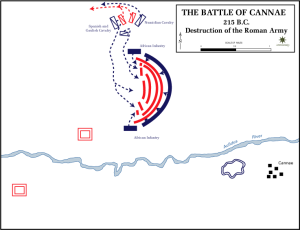The Battle of Cannae is one that shows how great of a military strategist Carthage’s Hannibal truly was. Cannae is yet another example of Hannibal inflicting mass destruction to the Roman army trough tactics. The battle took place on August 2nd, 216 BCE in southern Italy (Gabriel 45).
It all started when Hannibal’s men attacked a small Roman force in Cannae in order to provoke them into battle (Gabriel 45). The plan worked, and Tarentius Varro and Aemilius Paullus, both consuls of Rome, soon met Hannibal on the battlefield (Gabriel 45).
The armies confronted one another. The Romans yet again greatly outnumbered Hannibal’s forces with 70,000 soldiers, 6,000 cavalry, and allies from Italian states. The Carthaginians had only 35,000 soldiers, 11,000 cavalry with some allied, a few thousand skirmishers, and allies from Spain, Libya, and Celtic regions (Gabriel 45). As was the norm at the time, both sides formed rank with its soldiers in the middle and cavalry at the flanks (DeSouza 148). Yet Hannibal’s genius manifested itself in the details of his formation. He set the Libyan troops on the rear side flanks so they would come into play only during the latter part of the battle (DeSouza 148). On the Roman side, Varro put his heavy soldiers in the middle to crash and break Hannibal’s front line. Knowing this, Hannibal set his weak and light soldiers in the middle to swiftly move away from the advancing Romans–he knew he had little chance of facing them head on. As his weaker troops retreated (and the formation moved from convex to concave), the Romans became surrounded (DeSouza 148). The idea of surrounding the opponent’s forces is where Hannibal’s ultimate strategy comes into play which leads to a Carthaginian victory. Not just any general can surround and overcome a force that has twice as many men. It took knowledge of his opponent, thoughtful planning, and great military strategy.

Photo courtesy of The Department of History, US Military Academy
As seen from the image above, Hannibal began with a crescent formation with the convex side facing the Roman forces and placed himself in the middle. He knew that the Romans would be drawn to him. The Romans first charged into Hannibal’s weakest line and funneled into the center, as they were lured in by the promise of easily killing Hannibal (DeSouza 148). Meanwhile, the Spanish and Gallic cavalries engaged the Roman cavalry on the left flank while Rome’s cavalry engaged the Hannibal’s Numidian cavalry on the right (DeSouza 148). Yet Hannibal had stationed the majority of his cavalry on his left flank, making it the strongest on the field. Because of this, Hannibal’s cavalry on the left flank defeated its Roman opponent and thus was able to go around behind the Roman army and engage Rome’s cavalry on the right flank as it attacked the Numidian cavalry. Thus, the remainder of Rome’s allied cavalry was surrounded and defeated. The entirety of Rome’s cavalry either died or retreated early on in the battle (DeSouza 148). With no cavalry, Rome was in a fragile state. Hannibal’s lightly armed Spanish and Gallic troops in the center continually retreated back to form a crescent around the Roman forces which continued to funnel into the center of the crescent (DeSouza 148). The strategy was a success.
Hannibal’s crescent worked perfectly. Once the Spanish and Gaulish forces on the front middle line were fully retreated, Hannibal’s cavalry attacked the Roman rear flank in order to block potential escape routes (DeSouza 148). In addition, the African infantry which Hannibal had kept waiting in the rear side flanks engaged Roman forces from the side to help fill in any gaps. The Roman forces were fully encircled (DeSouza 148). Completely surrounded and unable to fight in typical formations, the Romans were slaughtered by the Carthaginians (Roth 48).
Rome sustained great casualties on this day. Among the casualties were the consul Paullus, two proconsuls, both quaestors, 29 of 48 military tribunes, and 80 senators, as well as an estimated 50,000 soldiers (Roth 48). The Carthaginians however, lost roughly around 5,000 to 8,000 men, an amazingly small number of casualties considering the forces they faced (Roth 48).
Hannibal’s great military genius is evident in the Battle of Cannae. He went to battle against the mighty Roman army, with forces about half the size of Rome’s forces. He was an underdog in terms of numbers, but his strategy made up for his lack of numbers and size. The crescent trap that he had set on the Roman army worked perfectly. Each step from the formation to the closing of the crescent was done efficiently due to his leadership and mastery in military tactics. If even one step had failed, the outcome of the battle could have been totally different. His success is due to his ability to prevent the Romans from fighting in their normal coordinated fashion in legions. Once the Romans were surrounded, slaughter ensued. One man’s intelligence defeated an army of one of history’s largest empires which consisted of numerous generals, soldiers, politicians, and military masterminds. The amount of destruction he inflicted on the Roman army was unparalleled, and he did so with a relatively small army. It was his innovations and brilliant military tactics that made him the most effective opponent the Roman Empire would face.

